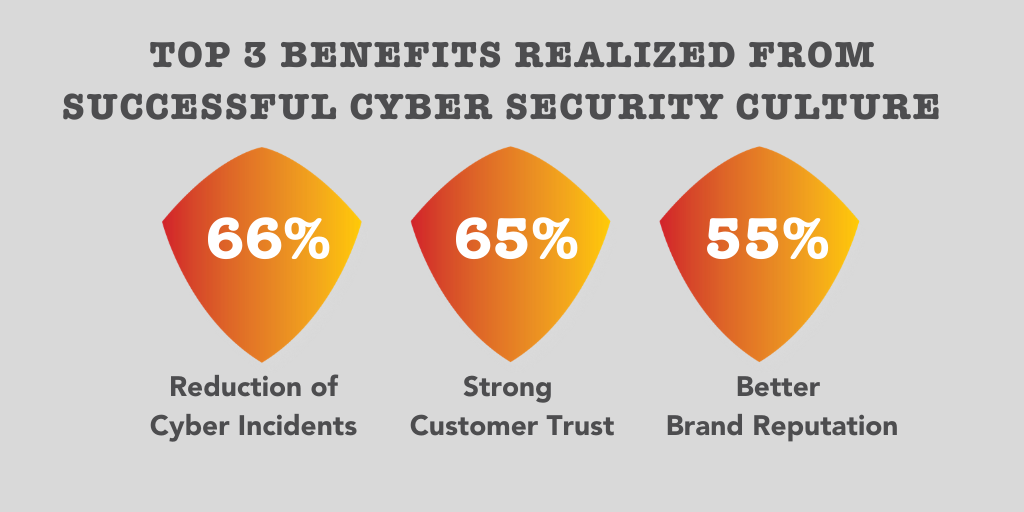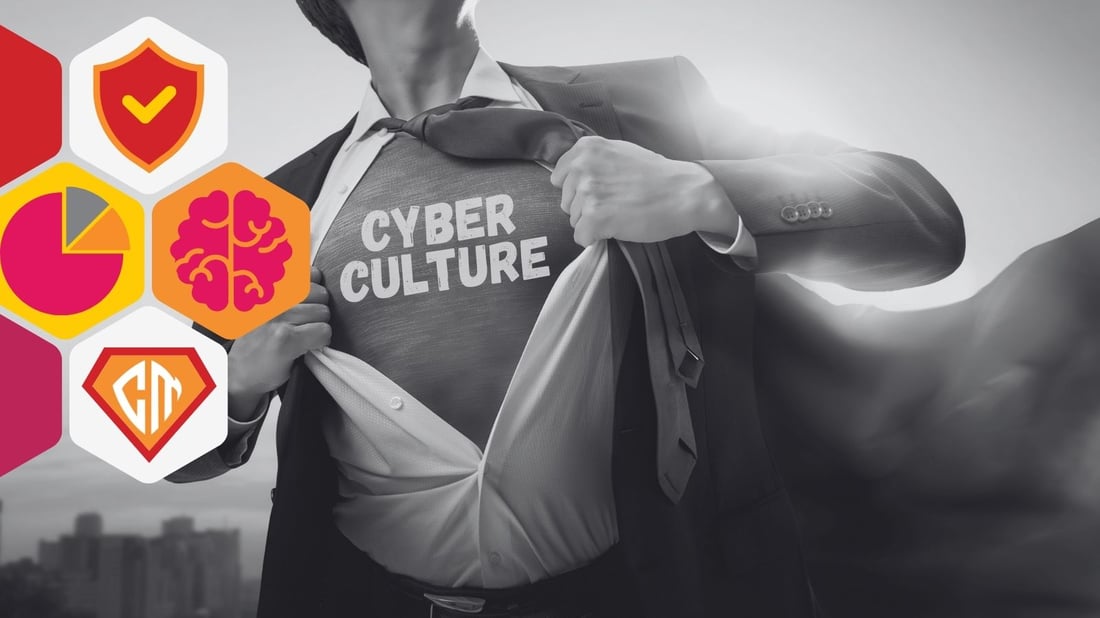Cyber Culture for CISOs: Questions the Board Will Ask (and How to Answer)
If you’re a CISO, you already know this: the board is suddenly very interested in “cyber culture.”

In the vast annals of history, tales of heroes and their epic voyages have captivated us. Today, our journey unfolds not on ancient seas, but within the intricate web of the digital realm.
Cybersecurity, once a niche pursuit, now intertwines with every facet of our lives. Like Odysseus with his sirens and cyclops, we navigate complex cyber threats and the ever-present maze of human behavior. We've reached a moment of inflection, where our narrative evolves from sheer technological reliance to embracing the human core of our digital saga.
Our path through the digital expanse isn't charted by machines alone. Behind each defense and line of code lies a person with emotions, biases, and potential. It's their ingenuity and resilience that will shape the course of our shared digital future.
As we venture further, remember: in the story of cybersecurity, while technology equips us, it's the spirit of humanity that truly guides our Odyssey to safe shores.
Historically, cybersecurity emphasized technical solutions, often sidelining the human component. However, as the discipline evolves, there's a growing acknowledgment of the human role in shaping cyber environments.
As we advance, understanding this dynamic becomes imperative for a holistic cybersecurity approach, emphasizing the importance of not just technological fortifications but also human behavior and psychology. This synergy, when effectively understood and harnessed, can greatly enhance organizational cybersecurity strategies.
Cybersecurity is more than an IT function—it's an organizational ethos. This holistic perspective recognizes the importance of both the tangible, like our digital infrastructure, and the intangible, such as the behaviors and values of employees on our teams. The field has traditionally been seen through a primarily technological lens. Yet, as digital threats become more nuanced, this unidimensional view is proving to be limiting.

Culture shapes behaviors and attitudes, influences decisions, and, when cultivated correctly, can serve as a powerful line of defense against cyber threats. It’s not about mere compliance or top-down policies; it's about nurturing an environment where security becomes second nature to every individual.
The challenge presented about applying this dimension to current cybersecurity challenges is that this cultural aspect has historically been sidelined. Cyber initiatives have primarily targeted immediate vulnerabilities, of which there are many but at the expense of neglecting long-term human behaviors that could either be an organization's weakest link or its strongest shield.
Yet, there's a shift on the horizon. Progressive organizations now realize that a robust cybersecurity strategy requires balancing the technical with the human. By understanding the differences and leveraging the cultural underpinnings, we can architect not only fortified systems but also resilient human networks ready to face the evolving cyber landscape.
The language and narrative we employ in the realm of cybersecurity significantly shape our perspective, approach, and ultimately, our solutions. A widely disseminated notion is that humans, dubbed “the weakest link”, act as the last line of defense against threats – the so-called "human firewall".
Imagine being called a "firewall". The inherent implication is the expectation for you to fend off intricate cyber threats—a colossal responsibility, especially when one lacks adequate tools and knowledge. It's akin to sending soldiers into battle without armor or strategy. By perpetually iterating that they are the weakest link, we're doing a disservice to their potential.
It's high time we shift our paradigm. Instead of viewing individuals as potential points of failure, we should recognize and respect them as invaluable assets capable of both understanding and advocating for responsible cybersecurity when adequately supported.

The solution isn't to burden employees with the enormous weight of being the final bastion against cyber threats. Rather, it's to empower them, to nurture a culture where they become facilitators of security, integrated seamlessly into the very DNA of the organization.
This reimagined perspective not only boosts morale but also encourages a proactive stance towards cybersecurity, transforming it from a dreaded chore into an embraced responsibility.
At the crossroads of cyber defense, two concepts frequently become intertwined – awareness and culture. It’s easy to mistakenly assume that they represent the same philosophy.

Cybersecurity awareness is an educational process. It primarily aims to enlighten individuals about the gamut of cyber threats and provide foundational knowledge on safe practices. Compliance-driven initiatives, which frequently manifest as annual training sessions, have fueled the concept. But herein lies a misconception: that making someone aware of a digital peril automatically renders them proficient in handling it. As any academic would attest, understanding a theory doesn’t necessarily translate to its effective real-world application.
On the other hand, cybersecurity culture delves deeper. It's not just about communication and imparting knowledge; it's about shaping behavior, fostering values, and engraining habits. It's an intricate tapestry woven from collective experiences, shared beliefs, and consistent practices across an organization. While awareness is needed as the spark that enlightens, culture is the enduring flame that guides and warms.
Technology has revolutionized our world at an unprecedented pace. From Gutenberg's Bible to the ubiquity of smartphones and the marvel of generative AI, the human race has witnessed a whirlwind of progress in a relatively short span. With such rapid evolution comes an inevitable challenge: keeping pace.
Understandably, many people in your company find the pace of change overwhelming, struggling to stay abreast with the latest technologies, security guidelines, and ever-evolving digital tools.

A culture where individuals feel heard, where friction points are identified and smoothed, and where the ethos and purpose of cybersecurity are embraced, not enforced. By leveraging insights from both psychology and anthropology, we can foster a space where understanding and empathy drive security, not just compliance.
Behind every interface and every system is a human being. For a CISO and our information security teams, this means recognizing the inextricable link between the individual components and services of an organization and its broader cybersecurity strategy.
While we can continually update tools and technologies, updating human behavior isn't always straightforward. Herein lies the power of culture and psychology—these tools move beyond identifying vulnerabilities to understand the root causes and foster a sense of proactive defense.
As CISOs, the challenge is to embrace a holistic, human-centric defense approach that prioritizes empathy and dialogue. With that in mind, let's consider key questions to integrate this perspective into existing frameworks and pave the way forward.
How do we integrate this approach within existing data and frameworks? Here are pivotal questions that might be echoing in the mind of a CISO:
Where does our organization stand?
Before embarking on the journey of cultivating a cybersecurity culture, understanding the current landscape is essential. What is the present state of cybersecurity maturity within the organization?
Who are our allies?
While the IT and cybersecurity teams are obvious stakeholders, who else within the organization can contribute? Could HR, training, or even marketing teams offer insights or resources?
Where can expertise be sourced?
Recognizing that traditional IT experts currently on staff might not be versed in the nuances of human behavior, where can the organization find experts in culture, psychology, or even anthropology to enrich their approach?
How can we measure impact?
Beyond the tangible metrics of reduced breaches or incidents, how can we gauge the evolution of our organization's cybersecurity culture?
While tools and technology can be updated, humans are not so easily reprogrammed. It's a matter of culture, of ingrained habits, of deeply seated beliefs. It’s in these areas that the tools of culture and psychology become invaluable.

By reflecting on these questions, CISOs can craft a roadmap that marries the best of both worlds—technology and humanity. The next sections will delve deeper into the actionable steps, providing a blueprint to actualize the principles we've discussed thus far.
In the cybersecurity realm, there’s a fundamental principle we can't get away from: you can't protect what you don't invest in. For far too long, the focus of Information Security has been disproportionately skewed towards investing in protecting technology, while the human aspect—arguably the most vulnerable link—has remained sadly underfunded.

The second factor is even the Cyber Awareness market’s prevailing paradigm, which leans towards commoditization, especially with large, older cyber awareness training providers peddling content within Learning Management Systems (LMS). By packaging cybersecurity awareness as an asset and then locking organizations into long-term subscription models, these providers in some ways have propagated a superficial approach to a complex issue.
But here's the uncomfortable truth: continuing to allocate a mere 2% of cybersecurity budgets toward understanding, training, and equipping humans will perpetuate the cycle of vulnerability.
CISOs must confront a longer-term perspective, favoring not just immediate, short-term gains but also the long-tail benefits of holistic, agile approaches. Investing in culture, psychology, and behavior isn’t about quick fixes; it's about seeding virtuous cycles that compound positively over time. Much like a concrete wheel, these initiatives may seem slow and cumbersome at the outset but, when energized consistently, gain remarkable momentum. Though the tenure of a typical CISO averages 2-3 years, the vision needs to transcend the immediacy. As the saying goes, "The true meaning of life is to plant trees, under whose shade you do not expect to sit." Our cybersecurity strategies should echo this sentiment, laying the foundations for a safer, more resilient future—even if we aren’t directly there to witness it.

The investments made today will determine the organization's security posture tomorrow. It's past time for the cybersecurity world to shift its gaze from purely technological fixes to the humans operating within these systems. Only with a balanced investment in both can organizations hope to build a truly resilient cybersecurity ecosystem.
Every organization possesses a distinct cultural DNA, characterized by unique values, behaviors, and attitudes. It's this intricate fabric of traits that drives how individuals adhere to rules, manage uncertainty, and engage with diverse subjects - including security. Recognizing that a vibrant corporate culture already permeates the workforce is foundational for integrating cybersecurity seamlessly within it.
To effectively lay the groundwork for a cybersecurity culture, executives must deeply engage with their organization's ethos. This entails not just acknowledging the surface-level behaviors, for example, but delving into the nuances of how employees perceive protection across various domains. With a comprehensive understanding of these cultural nuances, strategies can be tailored more effectively, ensuring they resonate and align seamlessly with the organization's heartbeat

Crafting a robust cyberculture isn't a mere checklist of actions; it's an art that varies with each organizational canvas. The alignment of an organization's innate culture with cyber strategies paves the way for a stronger, resilient defense rooted in the daily operations and ethos of your unique company.
CISOs must possess both an aerial view of the organization's cultural landscape and a grounded insight into its current cybersecurity posture. The overarching goal is straightforward: cyber-aware individuals who function within a framework where a security mindset is organically woven into the business fabric. To transform this vision into a tangible reality, the strategy (drawing inspiration from the ancient Greek military paradigm) serves as the roadmap.
To set the course, begin with a Human Baseline Assessment or culture audit. A good assessment captures the current cultural and security climate through detailed surveys and analyses. It's akin to taking the organization's pulse on security alignment within its prevalent culture. With this foundational knowledge, CISOs can begin to architect a comprehensive blueprint of the current human risk landscape.
Crafting an effective cyberculture change program goes beyond mere campaigns, posters, or generic training modules. It's about deeply understanding your organization and its unique culture, then tailoring strategies that resonate and effect genuine culture change there. Here are some actionable steps and considerations for CISOs aiming to operationalize their findings:
Deep Motivation: Merely imparting information isn't enough. Understand your employees and what drives them. Consider blending awareness with emotion—whether through humor, empathy, or innovation—to truly make an impact.
Resource Allocation: An effective program demands dedication. Allocate resources to understanding the intricate relationships between culture, training, awareness, and change. Establish a pre-planning strategy, identify goals, and assemble a dedicated team.
Continuous Engagement: A one-time training isn't sufficient. Design an ongoing plan addressing various risk levels and competencies, presented in a manner that appeals to your employees.
Understand Your Audiences: It's essential to comprehend the intricacies of your organizational culture. Consider using constructs like our "Digital Tribes" to decipher the intricate web of cultural attributes, values, habits, and behaviors. This "bottom-up" approach ensures a tailored strategy for varied employee groups.
Move Beyond One-Sized Training: While delivering one module a year for compliance might seem practical, it's an overly simplistic approach. Even role-based training is a great step, the goal in mapping the program is to seek granularity; and understand that roles and risks often overlap and intermingle.
Audience-Centric Approach: Instead of a "one size fits all" mentality, dive deeper. Recognize the uniqueness of each department, group, or team. For example, customer service might include a group with varied roles from HR to frontline representatives; understanding these intricacies helps tailor the program.

In essence, building a cyberculture program is an intricate endeavor. It's not about the generic or the general but the specific and tailored.
Investing time, resources, and thought into understanding your organization will pave the way for a more resilient and informed workforce.
In the evolving realm of cybersecurity, a holistic, human-centric approach isn't just the future—it's a necessity. As we've unpacked, moving beyond the limitations of traditional training and genuinely understanding your organizational culture are pivotal. But knowing the path and walking it are two distinct feats.
Recently we've heard CISOs mention culture for board-level cyber security risk management. Knowing that training is not the same as culture, and human behavior won't change on the spot- we have to move past cyber awareness and posters as a strategy for change. It's time to open up a discussion on qualifying, quantifying, and otherwise describing your resilient cyber culture with the new tools and techniques available in the market today.
Many CISOs feel the weight of this transition, sensing the need to grow but grappling with the "how." Matching theory with practical programs can be challenging to tackle in-house with limited resources, a shortage of experience within the awareness community and with internal teams to these emergent approaches, and the analysis and deeper metrics required to prove the investment in human-centric culture-first cyber programs are working.
At Cybermaniacs, we pride ourselves on our innovative, tailored approach to development, ensuring your cybersecurity strategy isn't just strong but is deeply integrated with your unique organizational DNA. Don't settle for "good enough." Engage with a team that's as passionate about your security as you are, ready to guide and collaborate on every step of your cyberculture journey.


If you’re a CISO, you already know this: the board is suddenly very interested in “cyber culture.”
17 min read

While firewalls, passwords, and antivirus software stand as stalwart defenders, there's one crucial element often overlooked in the defense arsenal:...
4 min read

Cybersecurity Awareness Month—love it or hate it, there's no denying it's like the Marmite of corporate initiatives. Every October, organizations...
6 min read
Subscribe to our newsletters for the latest news and insights.
Stay updated with best practices to enhance your workforce.
Get the latest on strategic risk for Executives and Managers.
